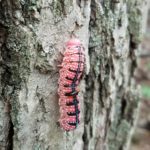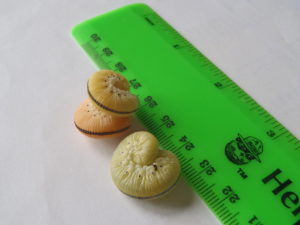Elm sawfly is the largest sawfly found in North America and has the disturbing habit of falling out of trees when you walk under the tree. They feed on willow and elm, although in Wisconsin I’ve only seen them causing noticeable defoliation on willow. They may also feed on birch, aspen, basswood, and maple. Most people don’t notice the damage until the larvae begin to migrate down and gather near the base of the tree. Larvae will overwinter as pupae on the ground and emerge as adults the following year.

Elm sawfly larvae are typically yellow; it is uncommon to find the pink form. (Photo by Ricky Keller)
Larvae grow 1 ½ – 2 inches long and are usually a bright yellow color with a black strip down their back, although occasionally the pink form is found. Adults are a large, dark brown sawfly that looks like a cross between a horse fly and a wasp. Usually defoliation is localized to a single tree or group of trees. Spraying a general insecticide or soapy water should kill these sawflies if you think control is warranted, but these late season defoliators rarely do serious damage to the trees that they defoliate.
H ere you can see how large elm sawfly larvae are, and there are some slight color differences in these. (Photo by Chris Plzak)
ere you can see how large elm sawfly larvae are, and there are some slight color differences in these. (Photo by Chris Plzak)
Written by: Linda Williams, forest health specialist, Woodruff, (Linda.Williams@wisconsin.gov), 715-356-5211 x232.
